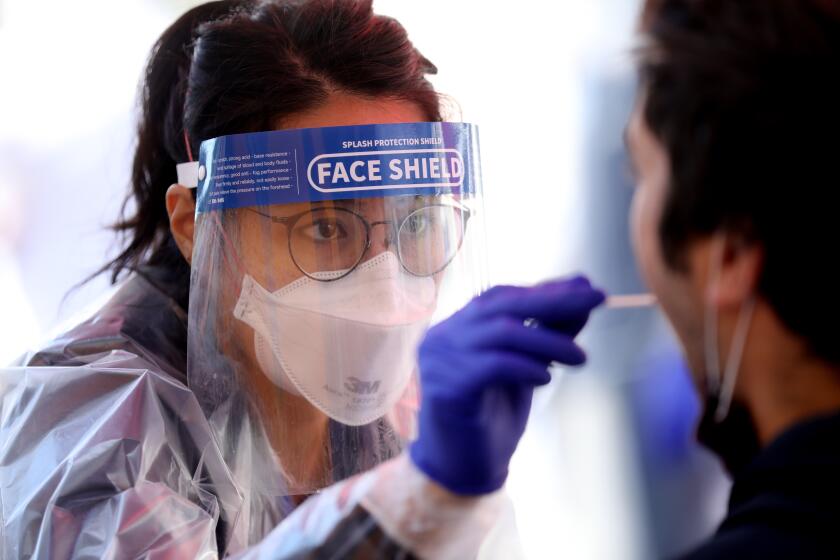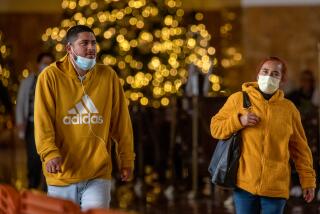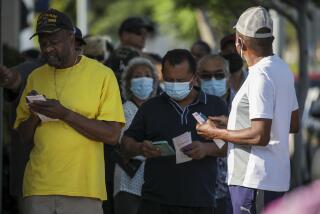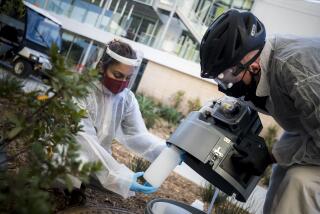San Diego County hangs on to Tier 2 status for COVID-19 reopenings
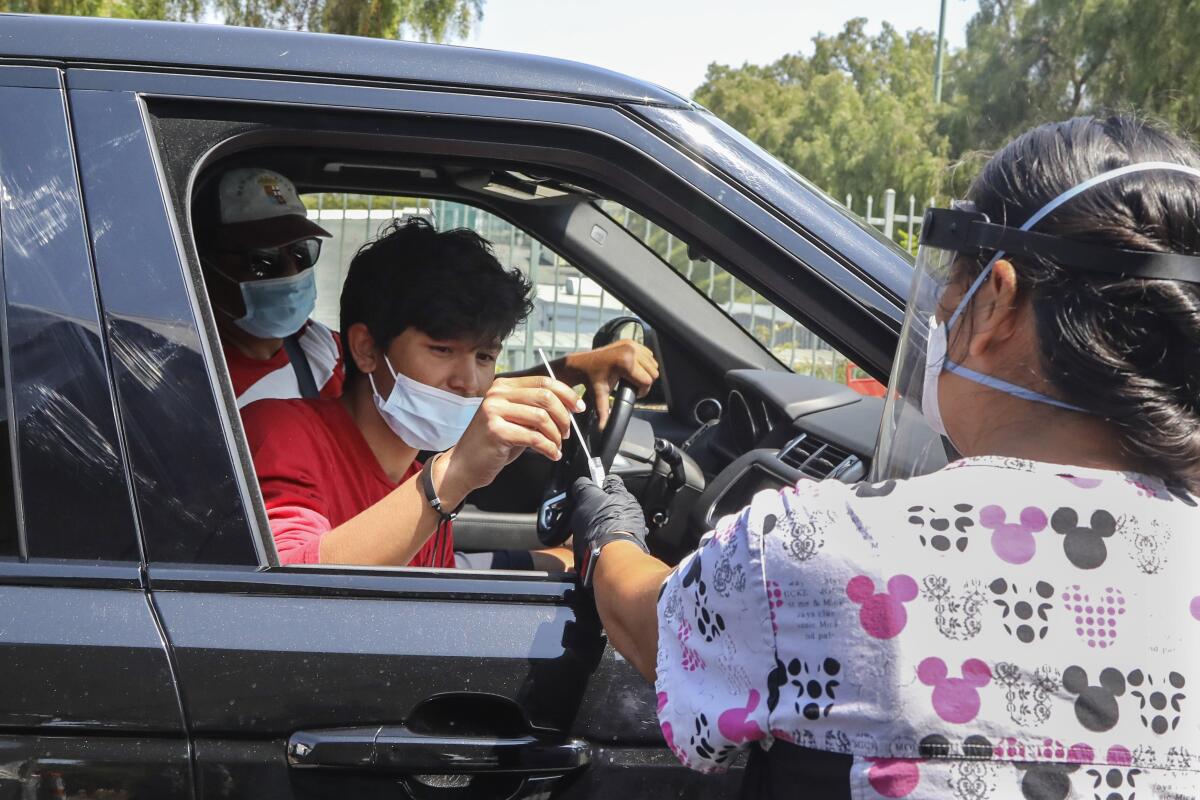
- Share via
It will be another week in the red for San Diego County, with continued high coronavirus testing rates nudging the region away from the potential for advancing in the state’s weekly tier assessment.
The latest report, released Tuesday, keeps San Diego in its current spot in the red tier, one from the bottom of the state’s four-level ranking system.
But it also includes a new measure that will prevent further advancement to less-restrictive rungs of the reopening ladder until significant progress is made in reducing the number of positive tests in the region’s most disadvantaged neighborhoods.
The state’s new “health equity” score calculates a separate positive test rate for census tracts in each county that score lowest on the California Healthy Places Index, a classification system that uses a range of socioeconomic statistics to pinpoint the location of the most and least disadvantaged neighborhoods.
California establishes a reopening requirement for counties: Reduce infections in communities where the poor and people of color live.
Starting this week, the state is calculating a cumulative test positivity rate for the 25% of local census tracts deemed most disadvantaged by the index, and counties cannot advance in the tier system unless they meet limits for the county as a whole and also for the areas deemed most disadvantaged.
At the moment, that’s not happening in San Diego.
The county’s overall positivity rate was 3.5% in the state’s latest report, qualifying the region for the next highest and less restrictive tier — color-coded orange. But the positivity rate for the roughly 150 census tracts in San Diego in the lowest quartile of the quality index, according to the state, have a composite positivity rate of 6.2%. Positivity rates must be below 5% for two consecutive weeks in order for a region to move up a tier.
The stark assessment that some locations see a positive testing rate nearly twice as high as the region’s average surprised no one. Rates in some South Bay and East County ZIP codes have long exceeded those of the region as a whole.
But seeing the number still so high, said Roberto Alcantar, chief strategy officer for the Chicano Federation of San Diego, provides fresh motivation for the coronavirus outreach and education work that many local organizations are currently doing in the communities they serve.
Many are surely wondering how San Diego County will collectively reduce the test positivity rate in those areas highlighted by the state. Alcantar said Tuesday evening that the work is already underway.
“For sure, the work to bring those numbers down has started,” he said. “There is a clear strategy between 10 nonprofit organizations that have contracted with the county to work together and address the systemic barriers that have made the rates higher in some communities throughout this pandemic.”
In August, the county signed outreach contracts with the federation, which leads a coalition of 10 Latino-serving community organizations, as well as with Mental Health America to work with local Black communities and Somali Family Service of San Diego to work with refugee communities.
The idea was to tap the local knowledge and connections that nonprofits have already built in the communities they serve and use those relationships to advocate for testing and disease-control strategies such as staying in county-provided hotel rooms after testing positive, and providing accurate and timely information to the contact tracers and case investigators responsible for containing outbreaks.
Some work is underway, Alcantar said, with COVID-19 information centers already online and testing centers in place on the premises of some trusted community organizations. Public service announcement campaigns, he added, will soon launch to reach more people in their native languages.
“We’re going to have more aggressive outreach with PSAs in Spanish, more speaking directly to the community through community forums,” he said. “We’re ready to take this on.”
At the moment, though, it is clear that the new positivity rate is not by itself holding the region back.
Counties can only climb out of their current tier if both of the numbers the state tracks weekly meet the requirements for the next level.
While San Diego’s positivity rate has consistently landed in the orange tier since the state’s ranking system was announced, its case rate — defined as the average number of cases per 100,000 residents — has consistently headed in the opposite direction, threatening to plunge the region into the lowest and most-restrictive purple tier. Such a fall would require many businesses and organizations, including restaurants, places of worship and gyms, to move their operations fully outdoors again.
As predicted, San Diego County was once again skirting the border between red and purple Tuesday with a raw score of 7, the limit beyond which the tier assignment changes from red to purple.
However, the county again benefited from an adjustment system built into the state’s ranking system. The raw rate was adjusted downward to 6.5 because the number of tests performed locally per 100,000 residents was 260, greater than the state’s median rate of 216. A similar testing-based adjustment kept San Diego out of the purple tier last week, reducing a raw score of 7.2 to 6.7, a number that is within bounds for the red tier.
Though countywide progress on the overall case rate will have to happen before the state’s equity rate is immediately relevant, it is clear that making it to the orange tier should be the long-range goal of anyone who wants to help their local businesses and organizations.
Moving up one notch would allow restaurants to double the amount of indoor capacity they are able to use, jumping from their current limit of 25% to 50%. Places of worship, movie theaters and museums, zoos and aquariums would experience the same increases for their indoor spaces. Gyms would be able to increase indoor usage from their current limit of 10% to 25%.
County officials encouraged people with and without symptoms who are at high risk for COVID-19 to be tested. Healthcare and essential workers should also be tested, as well as people who had close contact with individuals who have tested positive.
Sisson writes for the San Diego Union-Tribune. Union-Tribune staff writer Gustavo Solis contributed to this report.
More to Read
Sign up for Essential California
The most important California stories and recommendations in your inbox every morning.
You may occasionally receive promotional content from the Los Angeles Times.
